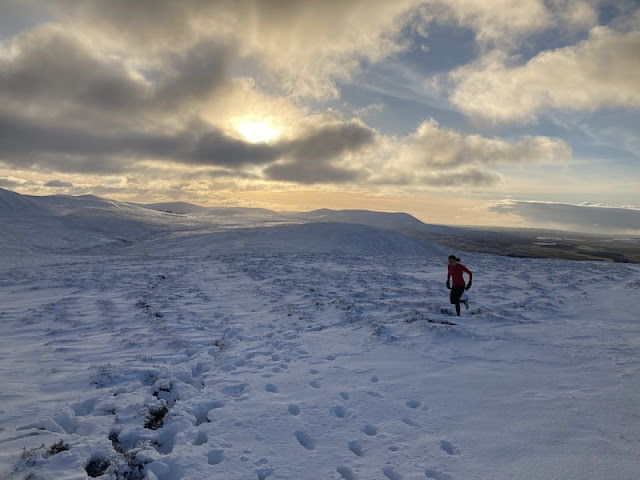We spent the family summer holiday in Switzerland this year, with the first week based in Grächen, and the second in St Luc, a village on the Sierre-Zinal race route. Apart from being a super family-friendly destination (car free, and playparks on every corner), Grächen also happens to be the start and finish point of the Ultra Tour Monte Rosa (UTMR), my target long race for 2021.
 |
| Feeling fresh, running from Grächen to Zermatt (photo © UTMR) |
Thanks to COVID-19, the UTMR didn’t follow its usual course this year, and stayed in Switzerland throughout, avoiding the usual high glacier section crossing into Italy. Nevertheless, the course was still a real challenge, and felt more demanding than the only other 100-miler I’ve done, the UTMB. The route was more technical, and wilder, with more climb (reportedly 11,000m ascent, in 175 km) and more exposure. The UTMR is a much smaller race, which gives it a more intimate friendly feel, like a marked fell race on a grand scale. Even on the altered route, the scenery was fantastic, especially the views above Zermatt onto the Matterhorn and Monte Rosa.
We arrived in Grächen 5 days before the race, and I spent the first night sleeping up high. I hiked up to 2200m after putting the children to bed, bivvied there for the night, before an easy run at altitude and returning to the family in time for breakfast the next morning. Having Konrad and the children around before the race was the perfect antidote to pre-race nerves, helping me to keep things in perspective. Knowing they would be waiting for me was also the best possible incentive to get me back to the finish line once the race was underway!
On race day I woke up at 2:45am, breakfasted and dressed in silence, making it out of the house without waking the children, and arriving in the town centre comfortably for the 4am start. I felt great for the first 60km, and especially enjoyed the section from the start in Grächen to Zermatt, which includes the incredible Charles Kuonen Suspension Bridge - the longest pedestrian footbridge in the Alps. Descending into Zermatt I caught up with Darcy Piceu – famous for her many finishes and wins at Hardrock 100 – and it was lovely to chat with her for a while as we climbed back out of the town, onto the massif above. The route circled around, taking in some incredible airy views of the 4000m peaks, before dropping back to Zermatt for an uncomfortable 20km of flat running down the hot valley to St Niklaus. It was a relief to arrive at the checkpoint there, and lovely to chat with Ruth Croft, who was volunteering on the event.
 |
| Running through Zermatt (photo Konrad Rawlik) |
Climbing out of the valley, I started to suffer and feel sick, but thankfully that didn't last long. As dusk approached the route dropped me to its lowest point (700m) before starting the longest climb of the race, thankfully broken up by the Visperterminen checkpoint, 110km into the race. Tom Owens was volunteering there and did an amazing job sorting me out for the hours of darkness that lay ahead. I ran by myself for most of the night, although there were often head-torches on the mountain side ahead of me, drawing me on. I felt overwhelmingly sleepy, and debated a power nap on the path, but in the end, I just sang out loud to keep myself awake (there were some decent drop offs to the side of the path), embarrassingly this night-time concert featured mainly nursery rhymes – the Grand Old Duke of York, amongst others! The terrain was increasingly rocky, rather like the summit section of Scafell Pike. I was vaguely aware that I should be loving the technical rock hopping, but my legs were tired and kept tripping and tangling themselves up, so I just concentrated on putting one in front of the other.
 |
| Descending to the finish (photo Liz Bailey) |
With dawn came new energy and the promise of the finish, and I tried to push on the final section from Saas Fee up to Grächen, although it was surprisingly technical, with a fair bit of scrambling and up-down in-outs of rock buttresses, which was hard on tired legs. I finished in 32 hours 26 minutes, in 9th overall, and was delighted to learn there that our friend Oli Johnson had smashed the overall race to win in 28 hours 23 minutes.
 |
| Sharing soup at the finish (photo Konrad Rawlik) |
UTMR is a race I would recommend without a moment’s hesitation. It has miles of stunning scenery and fantastic technical single-track paths, but what really makes the event is the volunteers at the checkpoints - it's like having your family waiting to care for you at every one. I am already looking forward to coming back and racing the full course.













